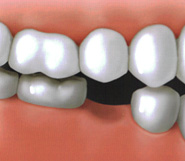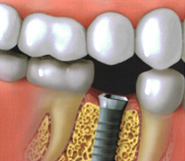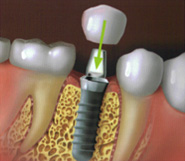Services:
Dental Implants:
If you are missing a tooth or multiple teeth, dental implants may be an option for you for a permanent tooth replacement. A dental implant is an artificial tooth root that a periodontist places into your jaw to replace one or more missing teeth without affecting bordering teeth. Dental implants are integrated with the gum tissues and underlying bone in your mouth. Under proper conditions and diligent patient maintenance, dental implants are predictable and can last a lifetime. Dental implants are teeth that can look and feel just like your own. Dental implants can be used to support a bridge as well as provide support for a denture, making it more secure and comfortable. The treatment plan is tailored to meet your needs. This procedure is a team effort between you, your periodontist, and your dentist. Your periodontist and dentist will work together in this is a multi-step process to determine where and how your dental implant(s) should be placed to replace a missing tooth or teeth with the root and crown.



Gum Grafting:
Periodontal procedures are available to prevent further dental problems and gum recession, and/or to improve the esthetics of your gum line. Exposed tooth roots can be sensitive, predisposed to root decay, and are not esthetically pleasing. Gum recession could be the result of periodontal disease or mechanic causes such as aggressive tooth brushing. Your periodontist can help you identify the factors contributing to the problem and if those factors can be controlled. A soft tissue graft procedure will repair the defect and help to prevent additional recession and bone loss. During this procedure, your periodontist takes gum tissue from your palate or another donor source to increase the tissue thickness and cover the exposed root if possible. This can be done for one tooth or several teeth.
Crown Lengthening:
Perhaps your teeth look too short, your smile is too gummy, or your tooth is decayed, broken below the gum line, or have insufficient tooth structure for a restoration, such as a crown or bridge. Your dentist or periodontist may recommend crown lengthening to make restorative or cosmetic dental procedures possible. Crown lengthening adjusts the gum and bone level to level and enhances your smile line or to expose more of the tooth so it can be restored. This procedure provides the groundwork for restorative and cosmetic dentistry and/or to improve the esthetics of your gum line.
Bone Grafting/Bone Regeneration:
When you have periodontal disease, the supporting tissue and bone is destroyed and pockets develop. Your periodontist may recommend a regenerative procedure to eliminate the periodontal pocket. A bone graft may be placed in that periodontal defect to stimulate your body’s natural ability to regenerate bone. These procedures can reverse some of the damage caused by periodontal disease before too much bone is lost and the tooth needs to be extracted.
Ridge Augmentation:
Tooth loss can lead to an indentation in the gums and jawbone where the tooth used to be. This indentation is unnatural looking. Ridge augmentation can be used to fill in this defect recapturing the natural contour of the gums and jaw. This procedure can also be used to re-grow or regenerate bone and/or soft tissue where it is needed to support a dental implant.
Tooth Socket Preservation:
The careful management of tooth sockets after tooth extraction is important and critical for the eventual placement of a dental implant. Your periodontist may perform a procedure called socket preservation immediately after atraumatic extraction of a tooth, if a dental implant cannot be immediately placed. The goal of this procedure is to prevent the bone indentations or defect so adequate bone volume is present for eventual dental implant placement. Ultimately, this results in the most esthetic outcome for tooth replacement.
Frenectomy:
A frenectomy is the surgical removal of a frenum in the mouth. A frenum is a fold of tissue that passes from the movable lip or cheek to the gum. A frenotomy is indicated when a frenum is positioned in such a way as to interfere with the normal alignment of teeth or results in pulling away of the gum from the tooth surface causing recession.
Pocket Reduction or Osseous Surgery:
When you have periodontal disease, the supporting tissue and bone is destroyed, and ultimately pockets form around the teeth. Over time, these pockets become deeper, providing a larger space for bacteria to develop, live and accumulate resulting in further bone and tissue loss. Eventually, if too much bone is lost, the teeth will need to be extracted. Your periodontist may recommend a pocket reduction procedure because you have pockets that are too deep to clean with daily at-home oral hygiene and a professional care routine. During this procedure, your periodontist removes the disease-causing bacteria. In some cases, irregular surfaces of the damaged bone are smoothed to limit areas where disease-causing bacteria can hide. This allows the gum tissue to better reattach to healthy bone. You may also need your periodontist to trim unhealthy or excessive gum to reduce pocket size during a procedure called a gingivectomy. Reducing pocket depth and eliminating existing bacteria are important to prevent damage caused by the progression of periodontal disease and to help you maintain a healthy smile. Reduced pockets and a combination of daily oral hygiene and professional maintenance care increase your chances of keeping your natural teeth.
Scaling And Root Planing:
If periodontal disease has progressed to more advanced stages, a special periodontal cleaning called scaling and root planing (deep cleaning) may be recommended. This is a non-surgical technique under local anesthesia that involves removal of plaque, tartar, and toxins from above and below the gum line (scaling) and rough spots on root surfaces are made smooth (planing). This procedure helps gum tissue heal and pockets to shrink. Adjunctive therapy such as medicated mouth rinses, local delivery of antimicrobials, or systemic antibiotics may be needed on a case-by-case basis to help healing and control the growth of bacteria. Non-surgical therapy does have its limitations and when it does not achieve periodontal health, surgery may be indicated to restore periodontal anatomy damaged by periodontal diseases and to facilitate oral hygiene practices.
Periodontal Maintenance:
Daily home cleanings help to control plaque and tartar formation, but those hard to reach areas will need extra special attention. Following scaling and root planing, patients usually will require ongoing regular maintenance therapy to sustain health. Your periodontist will determine your maintenance interval; however, typically periodontal maintenance cleanings occurs four times a year. At these cleaning appointments, pocket depths will be checked, x-rays taken as needed, oral examination, and oral hygiene is reviewed. Regular periodontal cleanings, along with good oral hygiene, are the vital to good oral and periodontal health.
Sedation:
To help alleviate some fear and anxiety, different forms of sedation are available ranging from nitrous oxide to IV conscious sedation.